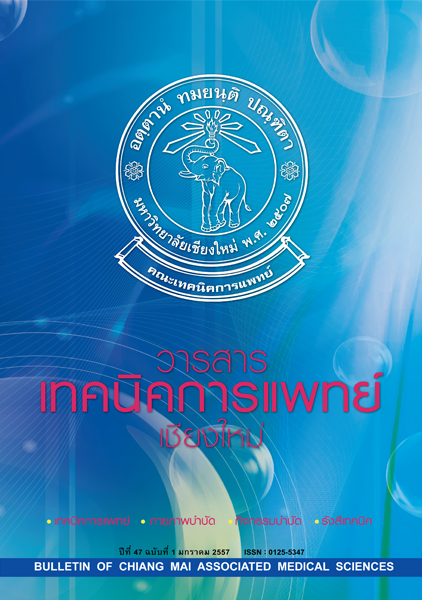Physiological changes following therapeutic sequence of hot pack combined with ultrasound over latent myofascial trigger point of upper trapezius muscle
Main Article Content
Abstract
Introduction: Myofascial trigger points (MTrPs) is a common musculoskeletal pain problem among office and computer workers. In physical therapy, the hot pack followed by ultrasound (HP+US) and the ultrasound followed by hot pack (US+HP) also have been using for treatment of MTrPs pain. However, these therapeutic sequences have not been investigated for physiological effects.
Objectives: The objective of this study was to evaluate the physiological changes on therapeutic sequence of hot pack and ultrasound over the myofascial trigger point of upper trapezius muscle.
Materials and methods: Thirty subjects (i.e., 24 females, 6 males, age between 27.3±4.3 years) with latent myofascial trigger point of upper trapezius muscle received both treatment conditions i.e., HP followed by US (HP+US) and ultrasound followed by hot pack (US+HP) by random with 24-48 hours interval between sessions. The outcome measures consisted of tissue blood flow: TBF, supra-thermal threshold: STT, pressure pain threshold: PPT and visual analog scale: VAS that were measured at baseline, immediate, post 30 minutes (post-30 min) and post 60 minutes (post-60 min) after treatment.
Results: The results did not demonstrate a significant difference in physiological changes between the treatment conditions (p>0.05). Considering the treatment condition, the tissue blood flow and pressure pain threshold were significantly increased from baseline for both treatment conditions (p<0.0001). The suprathermal threshold and pain visual analog scale did not significantly improve from baseline for both treatment conditions.
Conclusions: It may support that both treatment conditions potentially provided clinical benefits on TBF and PPT, but not for VAS and STT. This study may provide clinical application of physical therapy’s modalities for treatment of myofascial trigger point and musculoskeletal pain conditions.
Bull Chiang Mai Assoc Med Sci 2014; 47(1): 61-66
Article Details
Personal views expressed by the contributors in their articles are not necessarily those of the Journal of Associated Medical Sciences, Faculty of Associated Medical Sciences, Chiang Mai University.


